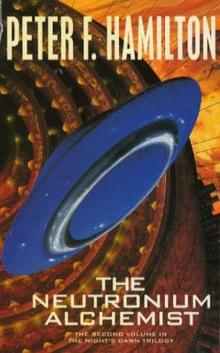- Home
- Peter F. Hamilton
The Confederation Handbook Page 4
The Confederation Handbook Read online
Page 4
Currency
The Edenist unit of currency is officially the dollar, though it is now referred to entirely as the fuseodollar. It is the strongest, most prevalent currency in the Confederation, remaining stable since 2135, and as such has become the standard against which every other currency is measured. With one or more habitats in most of the Confederation’s 862 inhabited systems (the principal exception being the Kulu Kingdom), and the infallibility and incorruptibility of the habitat consciousness which handles all fuseodollar transactions, Edenism has become through the Jovian Bank the premier interstellar banking institution.
The Jovian Bank has branches on a large proportion of planets and asteroid settlements throughout the Confederation (including the Kulu Kingdom), and all major multi-stellar organizations (such as the Confederation civil service) use the Edenist dollar as their currency.
Economy
The foundation of Edenist wealth comes from mining He3, the fuel used in fusion reactors throughout the Confederation primarily because of its clean burning qualities (low neutron emission) when combined with deuterium. Not only is it used for commercial power generation on- and off-planet, it is the principal drive system of all Adamist starships, both interstellar and interplanetary. The cloudscoop mining operation of gas giants, around which the habitats orbit, is considered to be owned by all Edenists equally, and its finance is administered by the habitat personality (see Finance, below).
The price of He3 remains the same throughout the Confederation, even in systems where there is no cloudscoop operation, and that price has remained stable for 500 years. Although not a pure monopoly, the Edenist operation is so large that anyone else running a cloudscoop operation is forced to supply He3 at the same rate.
When Eden and Pallas declared independence from the UN in 2090, they also initiated a (hostile) buy-out of the JSKP multinational consortium which had originally funded Jupiter’s atmospheric mining. Because of the enormous cost involved in starting up the operation, the debt was not paid off until 2135. After this the Edenists were truly independent. Fusion remains the major power source throughout the Confederation and, given the gas giant reserves of He3, is likely to remain so. Research continues into direct mass-to-energy conversion and other systems, but as yet none has demonstrated any practical application. Following the one serious attempt to break the Edenist energy monopoly, when Earth built antimatter stations, Confederation politicians have retained a policy of quiet moderation in this field.
The continuing demand for He3, and their use of self-sufficient bitek habitats, means that as a group Edenists have the highest socioeconomic index in the Confederation. It is worth noting that even if He3 fusion were completely abandoned by the Confederation, their bitek habitats, financial services, and industrial strength would mean that Edenists could retain their standard of living with little disturbance. Although Adamists complain bitterly among themselves about the He3 monopoly (excepting the Kulu Kingdom and Tranquillity) they also acknowledge that the Edenists, with their high ethical standards, are an ideal group to supply the Confederation with this fuel. Political blackmail is not an option ever considered by Edenists, even as regards the most oppressive Adamist dictatorships. Edenists regard the Confederation Assembly and its Navy as the only legitimate method of censure.
Finance
The habitat personality acts as bank and accountant for all financial transactions, corporate or personal. There is no physical cash in the form of notes and coins, and the fuseodollar is an entirely electronic currency, distributed through Jovian Bank credit disks.
Although Edenism is certainly not a Communist ideology, revenue raised from He3 mining is administered by the habitat personality, and made available on a communal basis; a research project or an artistic endeavor considered worthwhile, for example, will be funded from this central source. Capital for commercial enterprises is also advanced by the Jovian Bank. Edenists do not seek funding from Adamist banks, which is another source of contention, as Adamists frequently apply for loans from the Jovian Bank. Because of affinity, the habitat personality (through its financial sub-Consensus) is actively involved in the planning of commercial ventures from conception through to researching marketability, etc., so that when a project reaches the stage where finance is necessary to fund start-up manufacturing, it will always be granted.
Industry
Edenism is technologically and industrially self-sufficient, and the habitat-based companies export a great quantity of manufactured products across the Confederation. Problems with radiation shielding aside, gas-giant orbits are an ideal place to site zero-gee industrial stations, providing proximity to supplies of raw material, energy, and habitat populations. Jupiter is the greatest concentration of manufacturing capacity in the Confederation, even managing to out-produce Earth’s O’Neill Halo. Edenist companies tend to be run on a family level (extended family), with executive ownership spread among participating members; primary funding always comes from the Jovian Bank. Children of participants are eligible to work their way in after they reach legal maturity (at age nineteen).
Trade
The relative wealth of the citizenship, plus a prodigious appetite for luxury goods and exotic food make Edenist habitats an extremely valuable market for the Confederation, and commerce is correspondingly brisk. Adamist starship companies rarely have any complaints about Edenists in public or private, as their habitats, right across the Confederation, provide a huge market. Although He3 is Edenism’s main export, their high-technology astroengineering industries are also extremely competitive, and sell throughout the Confederation. Even though He3 is carried almost exclusively by voidhawks and Edenist-owned tankers, the shipment of manufactured goods is put out to free tender, and Adamist starships obtain a high percentage of the contracts. There are over 20,000 starship movements daily in the Jovian system, making it the busiest sector in the Confederation.
Habitats
These are bitek cylinders of living, highly modified coral (polyp), always found in orbit around gas giants. All Edenists live in these enclaves, with the exception of Atlantis (see page 53). In the Jovian system they orbit 550,000km above the planet, which puts them above the orbit of Io and its lethal flux tube and hazardous ion torus, but they keep well within the planetary magnetosphere, thus giving them a sidereal period of about two days.
They are grown from seeds (teardrop shaped, approximately 150m long and 50m wide), which are manufactured in specialist bitek stations, and are the largest artificial creatures ever designed (voidhawks and blackhawks claim to be more sophisticated). A new seed will be removed from its manufacturing station and germinated before being attached to a small asteroid (1km diameter) which contains appropriate trace minerals to support its initial growth phase. The first stage of germination produces a membrane which envelopes the entire asteroid, and then digestion begins inside. The membrane is flooded with enzyme fluid to break up the minerals, and these are reabsorbed by a root network. Minerals and organic compounds are processed inside the seed by rudimentary organs, and so polyp growth begins.
Once the basic cylinder shape is achieved, after four to six years, the seed and membrane sac digestive mechanism withers away and disengages. The cylinder at this point is 2km long, and is little more than an empty shell with a more sophisticated digestive system at one end. A new asteroid is maneuvered into its maw (a hemispherical indentation at one end, covered with spinelike cilia), and the primary digestion process begins. Growth to full size takes up to thirty years, and several asteroids are ingested during this time.
Layout and Composition
The first habitat to be germinated, Eden itself, is 10km long and 3km wide; the second, Pallas, is 15km long and 5km wide. Both are still alive, as cellular regeneration is constant provided the maw is fed with raw material. More modern habitats are up to 45km long and 10km wide, with hemispherical endcaps, and an external ring of starscrapers around the center. They rotate along their long axis to provide a 0.9 gra
vity field in the park, and a standard Earth gravity at the base of the starscrapers. Each habitat will typically house up to 2,000,000 people. The shell is 500m thick in total, which is more than sufficient to protect the inhabitants from Jupiter’s (and all other gas giants’) hostile radiation environment.
The external layer is made up from a crust of dead polyp 20m thick, which is gradually abraded away by particle impacts and vacuum ablation, though there are several surface sections of living sensitive cells which allow the habitat to “see” its surroundings. These cells receive and interpret a wide section of both the electromagnetic and magnetic spectrum, as well as being sensitive to elementary particles. The outer layer is constantly replenished from the first living polyp layer, which is nothing more than a sheath of living rock.
Above this is the extremely complex mitosis layer where the polyp is produced for the habitat’s interior and exterior. The mitosis layer is webbed with nutrient ducts fed from the maw digestive mechanism and organs; there are several distinct duct networks, each supplying a specialist fluid. Inward from the mitosis layer is the equally elaborate environment-support layer, which maintains the internal atmosphere, distributing oxygen, nitrogen, and water, which come from dedicated organs in the endcap. There are several reservoirs of each element, spaced at regular intervals throughout the shell. This layer also contains carbon dioxide filters to back up the vegetation in the cavern, while subsidiary filters eliminate any build-up of poisonous or toxic gas, and help purify the water.
Above the environmental layer is a tough sandwich layer where polyp encases the neural strata. The millions of homogenized thought routines which make up the habitat consciousness reside in the neural strata, which is affinity-capable. All biological aspects of the habitat are regulated from here, including autonomic functions; it also acts as an overall controller for the servitors.
Above the neural strata, a thick inner layer of polyp is contoured to produce a landscape for the central chamber. In the sections which break through the soil, providing imitation rock, paths, parkland structures, etc., the polyp is overlaid with sensitive cells giving the personality a comprehensive view of the interior. The polyp surfaces of the starscrapers are also suffused with sensitive cells.
Soil is spread over the internal layer, to a depth of several meters, supporting standard plant growth. There is a gentle gradient of 50m between the two ends of the chamber, with the lower finishing in a large circumfluous lake. Water is taken from the lake and pumped back to the higher end via channels lined with peristaltic muscles; it is released into the head of all the streams as well as being injected directly into the deep soil layers, allowing a constant circulation and irrigation across the chamber.
Starscrapers
Starscrapers are tower-like accommodation sections, up to 500m long, which protrude from the central section of the habitat, forming an equatorial band. There are windows on every level, giving spectacular views over the gas giants and their moon systems, and these are all fitted with irises which close during radiation storms. Essentially they are vertical towns, containing every civic amenity from individual apartments to theaters, with shops, bars, and offices included. Most Edenists live inside a habitat’s starscraper, given that there are few other internal structures; Edenists like to keep the chamber parkland unspoiled. The main exceptions to this rule are the habitats in orbit around Saturn, which have no starscrapers because of the higher particle density that makes them susceptible to damage (Saturn habitats have much thicker external shell layers).
All starscraper apartments are provided with food-synthesis organs, providing a steady if monotonous diet of fruit juice and paste-like protein-rich hydrocarbons of various flavors. Secretion teats are provided in every apartment wall. Human excrement is carried away through a digestive tract, and reprocessed in organ clusters at the base of the tower, while harmful toxins are vented through porous sections of the shell. The food organs are not widely used, since Edenists favor cooking food (there is no butchery—meat is grown in clone vats), and import a great many delicacies from across the Confederation. This waste matter finds its way directly into the ecosystem via the digestive tracts.
Power
Most of the biological processes within the habitat’s major organs utilize variants of electrolysis and ion-exchange mechanisms, rather than straightforward biochemical reactions. This reduces the dependence on fresh chemicals to a considerable degree, cutting down on the amount of minerals which have to be ingested. Though its chemical consumption is still prodigious, a habitat’s main power source is electricity. This energy is generated by simple induction from Jupiter’s (and other gas giants’) colossal magnetosphere.
Hundreds of specialist extrusion glands are situated around the rim at each end of the cylinder, producing 50m, lengths of organic conductor cabling. Because of the habitat’s rotation the cables extend straight outward and slice through the magnetosphere’s flux lines. (This means that spacecraft have to approach every habitat along the rotation axis.) Cables are grown on a more or less constant basis, as dust impacts continually weaken them and breakage is frequent. As well as indigenous organ functions and maintaining the environment temperature, the cables provide electricity for domestic use and the light-industry plants situated in the endcaps.
Habitats have a large reserve of electricity stored in electroplaque cells to cope with the fluctuations caused by cable breaks, and in emergencies fusion generators can be plugged directly into the power circuits. Without this pick-up system it is difficult to see how an organism like a habitat could survive, given the amount of energy it requires to heat, light and feed its inhabitants. Photosynthetic membranes, as well as being extremely inefficient, would be impossibly cumbersome on the scale required to provide an equivalent amount of energy.
Light
Electrophorescent cell clusters are used throughout the skyscrapers, although inhabitants are free to redecorate by using electric lighting (chandeliers and lasersolids are popular). The central cavern is illuminated by a column of fluorescent gas contained inside a webbed tube of organic conductors extending down the length of the axis. The web’s magnetic field confines the ionized gas, which is constantly fluoresced by a high-voltage discharge. During the night-time period, the luminosity is reduced to the light level of a full (Earth) moon. Repairs to the web are conducted during this period by bitek servitors specially designed to be resistant to the high magnetic flux level and energized gas; these creatures resemble giant spiders with a hard dermal layer.
Climates
Most types of climate exist in the habitats orbiting Jupiter, although Alaskan or Siberian winters are not easily simulated because of the thermal-flow problems this would create inside the shell. A Mediterranean-style climate is the most popular, followed by temperate or tropical. Several temperature habitats grown in the last 150 years have included an atmospheric vapor dispersion system supposed to create occasional snowfalls, though this has met with only moderate success. Eight Jupiter-orbiting habitats are dedicated nature reserves for rare original-genotype Earth animals, plants, and insects (for whales see Atlantis, page 53), with many species reconstructed from stored genetic samples taken in the late twentieth and early twenty-first centuries. One of the most successful reconstructions has been the mammoth cloned from frozen samples found in Siberia.
Mechanical Systems
Bitek is unable to accommodate every requirement, especially moving systems which are subject to constant abrasive use, and in particular transport mechanisms. Lifts are installed in all the starscrapers after they have been grown, and large tunnels are included in the internal polyp land-contour layer for the maglev trains. Cars and powered bikes are also used in the cavern, but only by service crews and medical emergency personnel. Cycling is popular, as is microlight flying and horse riding.
Spaceport
As one end of the habitat is devoted to the maw, spaceship activity is concentrated entirely around the other end. On all post
-2220 habitats, the endcap has a series of broad projecting ledges for voidhawks to land on. These rings are studded with pedestals which contain nutrient-fluid transfer mechanisms for the bitek starships; fluid-production organs are found in the endcap walls.
All Adamist starships and reaction-drive craft use a counter-rotating spaceport (none of them can perform the kind of swoop maneuver necessary to use a ledge), which extends out from the habitat axis on a long spindle. These are the same as spaceports on settled asteroids, though larger in scale, and can be any shape, from simple extensions of the spindle to discs, globes, and starfish grids. The only thing they have in common is that they are joined to the habitat by a rotating seal at the axis.
Defense
As with Confederation planets and asteroid settlements, starships are not allowed to emerge within 100,000km of a habitat, and they have designated emergence zones. In Jupiter’s case, starships are effectively banished from emerging inside Europa’s orbit. After emergence, docking authorization and flight-vector management is handled by the habitat personality, which is linked into strategic-defense platforms via bitek processor chips.

 A Night Without Stars
A Night Without Stars If at First . . .
If at First . . . The Neutronium Alchemist
The Neutronium Alchemist Great North Road
Great North Road Misspent Youth
Misspent Youth Pandora's Star
Pandora's Star The Evolutionary Void
The Evolutionary Void The Dreaming Void
The Dreaming Void Mindstar Rising
Mindstar Rising The Temporal Void
The Temporal Void A Quantum Murder
A Quantum Murder The Hunting of the Princes
The Hunting of the Princes Salvation Lost
Salvation Lost The Dreaming
The Dreaming Salvation
Salvation Light Chaser
Light Chaser The Mandel Files, Volume 2: The Nano Flower
The Mandel Files, Volume 2: The Nano Flower![The Saints of Salvation [British Ed.] Read online](http://i1.bookreadfree.com/22/the_saints_of_salvation_british_ed__preview.jpg) The Saints of Salvation [British Ed.]
The Saints of Salvation [British Ed.] Manhattan in Reverse
Manhattan in Reverse The Secret Throne
The Secret Throne A Window Into Time
A Window Into Time A Second Chance at Eden
A Second Chance at Eden The Nano Flower
The Nano Flower The Confederation Handbook
The Confederation Handbook The Naked God
The Naked God The Saints of Salvation
The Saints of Salvation The Void Trilogy 3-Book Bundle
The Void Trilogy 3-Book Bundle The Abyss Beyond Dreams
The Abyss Beyond Dreams A Voyage Through Air
A Voyage Through Air Judas Unchained
Judas Unchained The Commonwealth Saga 2-Book Bundle
The Commonwealth Saga 2-Book Bundle The Naked God - Flight nd-5
The Naked God - Flight nd-5 Night Without Stars (Chronicle of the Fallers Book 2)
Night Without Stars (Chronicle of the Fallers Book 2) Neutronium Alchemist - Conflict nd-4
Neutronium Alchemist - Conflict nd-4 Reality Dysfunction - Expansion nd-2
Reality Dysfunction - Expansion nd-2 Now We Are Ten: Celebrating the First Ten Years of NewCon Press
Now We Are Ten: Celebrating the First Ten Years of NewCon Press Neutronium Alchemist - Consolidation nd-3
Neutronium Alchemist - Consolidation nd-3 If at First . . . (Short Story)
If at First . . . (Short Story) A Second Chance at Eden nd-7
A Second Chance at Eden nd-7 Judas Unchained cs-2
Judas Unchained cs-2 The Mandel Files, Volume 1
The Mandel Files, Volume 1 Reality Dysfunction — Emergence nd-1
Reality Dysfunction — Emergence nd-1 The Temporal Void (ARC)
The Temporal Void (ARC) The Mandel Files
The Mandel Files Fallen Fragon
Fallen Fragon Misspent Youth (commonwealth saga)
Misspent Youth (commonwealth saga) If at First...
If at First... Best of British Science Fiction 2016
Best of British Science Fiction 2016 The Mandel Files, Volume 2
The Mandel Files, Volume 2 The Naked God - Faith nd-6
The Naked God - Faith nd-6 The Night's Dawn Trilogy
The Night's Dawn Trilogy Pandora's Star cs-2
Pandora's Star cs-2 A Window into Time (Novella)
A Window into Time (Novella)